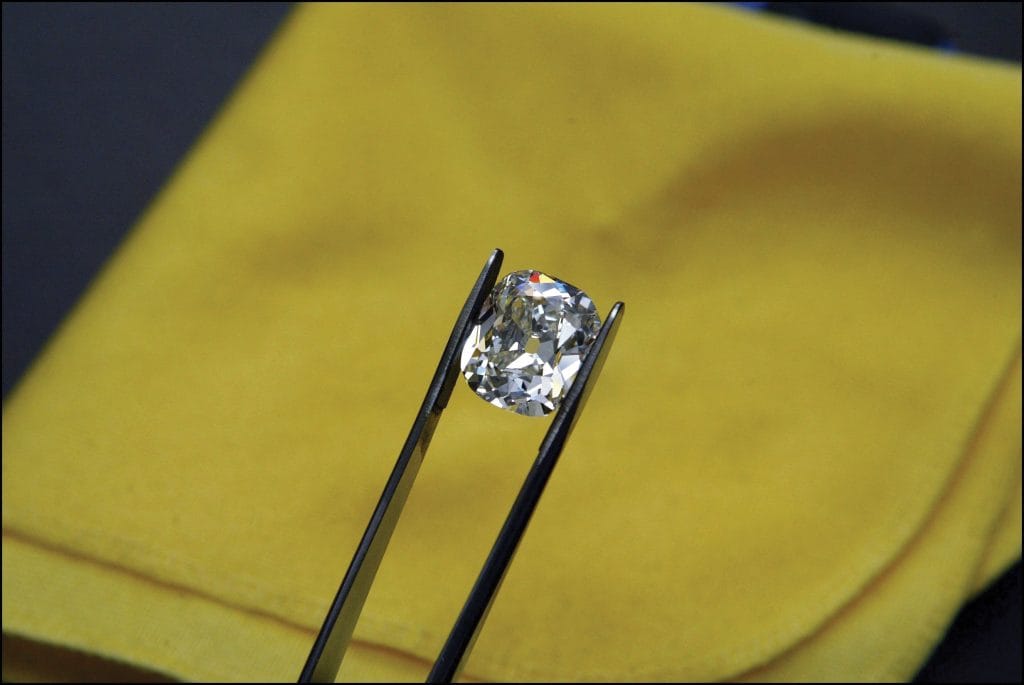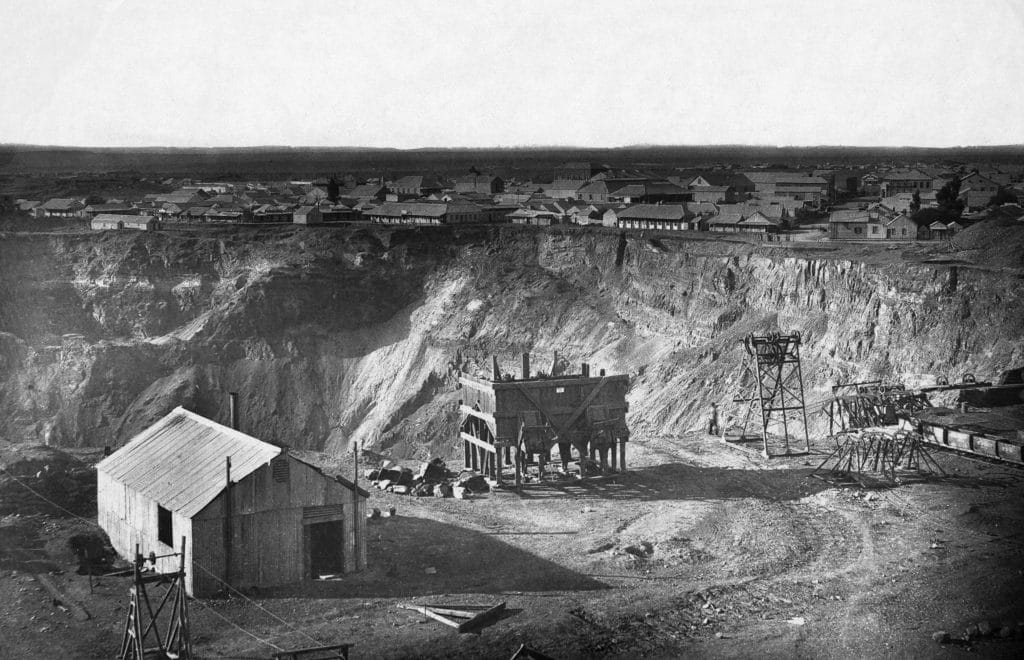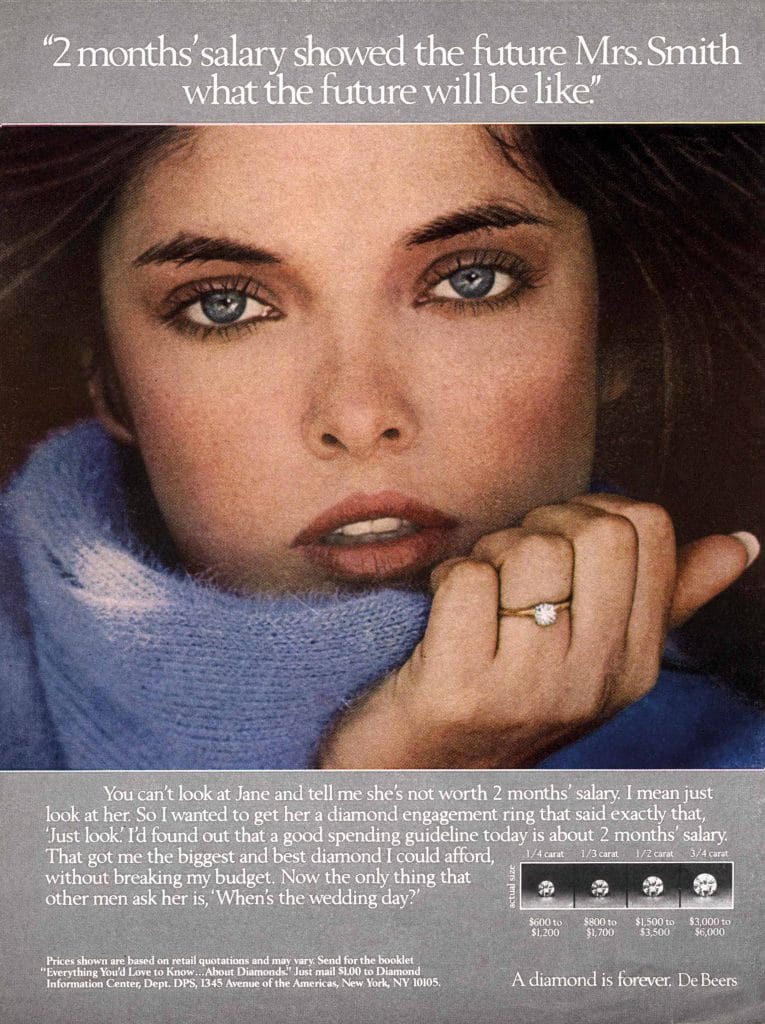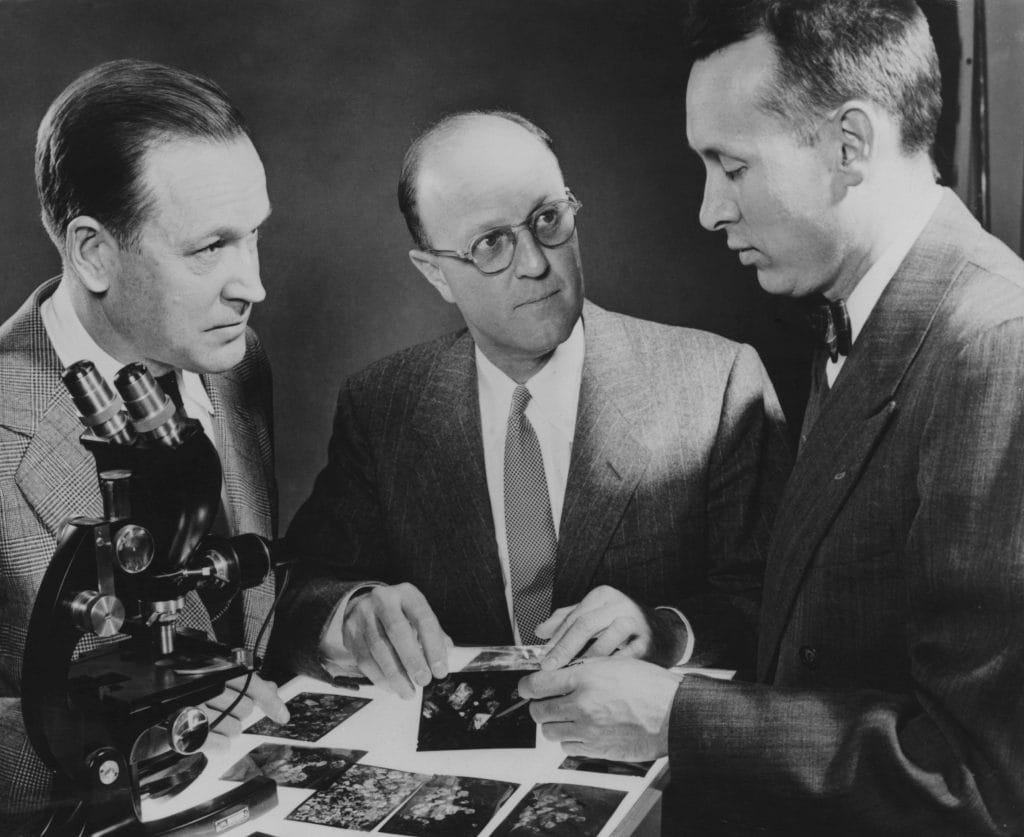Lucre in the sky with diamonds
On 30th October 2020 a potentially disruptive new force entered the diamond industry – a company producing carbon-negative lab-grown gems. Harriet Salem lifts the lid on all that glitters

Dale Vince, founder of Sky Diamonds, which creates jewels out of carbon drawn from the atmosphere. Photo: Jeff Moore
30th October 2020 (Taken from: #41)
Dale Vince doesn’t look like your typical diamond dealer. On the day we talk, he’s got his long grey hair stylishly slicked back and is dressed in a casual black T-shirt with a red and white keffiyeh-style scarf knotted around his neck. If you gave him a placard he’d blend easily into a crowd of protesters. “I was just kind of mind-doodling, thinking about climate change,” he says of the thought process behind his latest business venture, Sky Diamonds, launched in October 2020. “Then it came to me, that diamond is the most permanent form of carbon. I thought: wouldn’t it be great, a kind of modern-day alchemy, if we could take this toxic waste out the sky and make it into something beautiful, into diamond.”
After quitting school in England aged just 15, Vince spent much of the 1980s living in a converted Bedford J-type ambulance and railing against the injustices of Margaret Thatcher’s Conservative government. A self-described “new-age traveller”, he flitted between Rainbow Village, an “anti-war and anti-nuclear” squat on a former Royal Air Force base, and other communes. In his recently published autobiography, Manifesto, Vince remembers being caught up in the clashes between police and Peace Convoy travellers as they tried to set up the Stonehenge Free Festival in 1985. He recalls being chased by a helicopter while out scouting for police blockades on his Ducati motorbike. “I looked again over my shoulder at the pursuing chopper,” he writes, “and felt like I was in a James Bond film.”
While he says many of his new-age traveller friends became “dependent on the dole”, Vince looked for ways to make his radical ideas into reality. After erecting a windmill at the Glastonbury Festival to charge the mobile phones of revellers, he was inspired in 1995 to set up Ecotricity, a green energy company that went on to be phenomenally successful. Today, Vince’s life is a far cry from his wild days on the road with a “lifestyle that was outside the law”. Instead of a repurposed ambulance he lives in an 18th century mansion in Gloucestershire and is now worth £107 million. He owns Forest Green Rovers, the world’s first (UN-certified) environmentally friendly vegan football club (he also eats an exclusively plant-based diet), which is currently vying for promotion from English football’s fourth tier. The Daily Telegraph has described him as “Britain’s wealthiest hippy”.
His ideology, however, has remained constant. Vince says that Sky Diamond, his new venture, produces a world first: a carbon-negative diamond made entirely from thin air. “It’s kind of a 21st century Willy Wonka thing,” says Vince of his ‘Sky Mining Facility’ based in Gloucestershire which will be capable, initially, of producing 200 carats (40 grams) of gems per month. Chimneys will suck carbon from the air and hydrogen, needed to make the methane used in the process, will be created by technology that splits rainwater molecules. The energy required to create the heat and pressure to turn the carbon into diamond will all be renewable. “Wind, sun, air and rain, that’s our entire bling ingredient list,” says Vince. “And because each diamond is made from carbon captured from the air – about four or five grams I believe – we are actually cleaning the air for each one made.”
‘Sky Diamonds’ have yet to hit the market – the first will go on sale later in 2021 – but in true Charlie and the Chocolate Factory style Vince has selected ten lucky ‘diamond ticket’ winners who will receive gifts of the factory’s first gems. He’s clear, however, that the venture isn’t just about selling a few nice pieces of jewellery. While the process of making the diamonds takes carbon out the sky, Vince acknowledges its impact on climate change alone is likely to be minimal. The real aim, he says, is to replace the powerful diamond mining industry, worth an estimated $27.6 billion in 2019, with environmentally friendly manmade stones.
To produce the average diamond used in an engagement ring, between 200 and 400 million times its volume in rock is removed from the earth”
Conservative estimates place the annual amount of CO2 produced by diamond mining at over 7 million tonnes – equivalent to 1.5 million cars running for a year – but this is far from the only environmental damage caused by the industry. To produce the average diamond used in an engagement ring, between 200 and 400 million times its volume in rock is removed from the earth. The excavation, which creates pits visible from space, has a knock-on effect all the way through the ecosystem. The massive piles of stone and rock generated by the digging are often infused with processing chemicals and leach toxic waste, including acids and heavy metals, that seeps into groundwater.
While the lifespan of the average diamond pit is around 20 years, the resulting pollution and habitat loss can have a far longer term effect. In Zimbabwe’s Marange mines, one of the world’s biggest, chemical leakage into surrounding rivers has caused fish to die en masse. Local villagers have reported that their cattle became disorientated, lost their hair and died after drinking the local water. In Sierra Leone’s Kono district, abandoned diamond pits created topsoil erosion causing vegetation to disappear and wildlife to flee. The chasms in the earth filled up with stagnant rainwater infested with waterborne diseases and malaria-carrying mosquitoes.
Meanwhile, more than 579,000 square miles of sea floor – an area bigger than the entire landmass of South Africa – are currently leased to diamond mining operations. Dredging procedures use a 280-tonne mechanical arm to remove silt from the ocean floor, a process that scientists warn is causing unknown amounts of damage to this still largely unexplored deep-sea ecosystem.

Owned and operated by the De Beers Group, Venetia diamond mine is South Africa’s largest producer of diamonds, accounting for 40 percent of the country’s annual production. Photo: Mujahid Safodien/AFP
There’s also a human cost. Despite attempts to regulate the trade, ‘blood diamonds’ – those mined in active war zones and sold by insurgents or warlords to prolong conflict – are still thought to account for between one and five percent of stones on the market. “The bigger picture is the mining industry – that’s our main competitor, that’s the source of so much environmental damage,” Vince tells me. “We’re here to replace diamonds; that’s how we see it.”
The diamond ring
Humans have prized diamonds for millennia. Early Hindus thought they were created when bolts of lightning struck the earth. Ancient Greeks believed they were splinters of stars descending from the night skies. Romans, meanwhile, considered them to be the tears of the gods falling to the ground. Diamonds have been imbued with all kinds of magical properties, from warding off evil spirits to bestowing fertility.
Today we know that it is the densely packed atoms in diamonds that make them among the world’s hardest substances – the word ‘diamond’ comes from the Greek word adamas meaning ‘unbreakable’. Despite the massive advances in scientific knowledge, belief in the powers of diamonds is not entirely a thing of the past. Today, presenting a loved one with a glistening, expensive rock is seen across the Western world as a symbol of enduring and eternal love. Every year millions of marriage proposals are made by way of a diamond ring. The idea that “a diamond is forever” is, however, more myth-by-marketing, with its roots in British colonialism, rather than bona-fide folklore. It all started with Cecil Rhodes.

A diamond up close. Photo: Alain Benainous/Gamma-Rapho via Getty Images
Today Rhodes is widely viewed as a pariah, an imperialist and white supremacist who colonised what became known as Southern and Northern Rhodesia – today’s Zimbabwe – for the British Empire. Black Lives Matter protesters have called for his statue, on the front of Oriel College’s Rhodes Building in Oxford, to be torn down and for his name to be removed from an international scholarship programme at the city’s university. Rhodes’s poisonous politics may have fallen out of vogue, but one of his lesser-known legacies remains largely intact.
In 1871 Rhodes, aged just 17, travelled from the English market town of Bishop’s Stortford to South Africa in search of business opportunities and a more agreeable climate for his sickly constitution. After losing money borrowed from his aunt in a failed cotton farm venture, he headed to the country’s Northern Cape. It was here, on the banks of the Orange River five years earlier, that a young boy had picked up an unusual-looking rock. The chance find turned out to be a diamond – at the time one of the largest ever discovered. In the following years thousands of hopeful and desperate prospectors descended on the area to find their fortune. Among them was Rhodes. Unlike most, however, his plan wasn’t just to find diamonds. He wanted to build a diamond empire.
Instead of digging in the dirt, Rhodes rented steam-powered pumps to miners to drain their flooded claims. With his profits he bought up promising plots – lots of them. His claims, and wealth, multiplied rapidly. By 1880 his company, De Beers Consolidated Mines, owned a majority stake in one of the region’s most prolific diamond pits – a former farm owned by the Dutch De Beers brothers. But Rhodes didn’t stop there. As the end of the decade approached, he made his big power play. On 18th July 1889 he wrote a cheque for $12.8 million (the largest ever to have been written at that time) to buy the assets of Kimberley Central, De Beers’s biggest rival. At the stroke of a pen Rhodes, aged just 35, brought over 90 percent of the world’s diamond production under his control.
Rhodes used his fortune to fund mercenary armies to murder, steal, bribe, cheat and corrupt”
As Rhodes’s wealth grew, so did his power. Between 1890 and 1896 he served as Cape Colony’s prime minister, a position he used to ruthlessly advance his business interests. When his mercenaries seized Matabeleland, a resource-rich region of what is now Zimbabwe, he declared to his shareholders that the value of their investments had increased by 2,000 percent. He exploited not just Africa’s land but its people. “The native is to be treated as a child and denied the franchise… We must adopt a system of despotism, such as works so well in India, in our relations with the barbarians of South Africa,” he told the House Assembly in Cape Town. He was, as described by Anthony Thomas in his biography Rhodes: The Race for Africa, “a man who elbowed his way to a fortune in the no-holds-barred melee of the Kimberly diamond rush and then used that fortune to fund mercenary armies to murder, steal, bribe, cheat and corrupt in a headlong rush to secure as much as Africa’s land and mineral wealth as he could lay his hands on.”

Workers pose in front of the washing equipment at the Bultfontein diamond mine, Kimberley, 1888. Photo: Robert Harris/Henry Guttmann Collection/Getty Images
By 1872, a staggering 1 million carats (200 kilos) of diamonds were already being pulled from South Africa’s soil every year, equivalent to more than five times the amount mined in the rest of the world combined. Yet, while the huge cache of diamonds unearthed around the Orange River made Rhodes inordinately wealthy, it also posed a not insubstantial problem. Prior to the late 19th century, diamonds were extremely rare. Annually, only a few pounds were dug out of the earth, mostly in India and Brazil. It was this rarity that made diamonds so valuable. If diamonds became abundant then they were little more than sparkly gravel.

An open mine at the diamond centre of Kimberley, South Africa, 1888. Photo: Hulton-Deutsch Collection/Corbis via Getty Images
To stop prices from plummeting, Rhodes began to stockpile the stones De Beers mined instead of selling them. What mattered, he realised, was not whether diamonds were truly rare, but rather that they were perceived to be rare. He also established an elite group of London merchants known as ‘The Syndicate’ which had exclusive purchase rights on the De Beers gems. This absolute control, a cartel that stretched from mine to marketplace, meant that diamond prices could easily be fixed. And buyers, unaware of the ever-growing stash of sparkling stones in the company’s vaults, were willing to pay top dollar for the ‘rare’ jewels. “I often go and sit at the edge of the De Beers mine and look at the blue diamondiferous ground, reaching from the surface,” Rhodes once confided to a fellow businessman. “I reckon up the value of the diamonds in the blue and the power conferred by them. In fact, every foot of blue ground means so much power.”
Romancing the stone
Rhodes, dogged by poor health since he was a child, died of heart failure in 1902 at the age of 48. But the cartel he created continued to flourish. Indeed, by the mid-1930s De Beers had such an iron-tight grip over global supply that its new owner, Ernest Oppenheimer, a diamond dealer from Freiburg, turned his attention to another facet of trade: demand.
In 1938 the Oppenheimer family hired NW Ayer & Son, a New York-based advertising agency. It was no mean feat to drum up new customers in a country still reeling from the effects of the Great Depression and anxious about the potential of a new world war. Further complicating matters was the fact that De Beers sold rough diamonds, not end-market jewellery. Moreover, as cartels were prohibited by US antitrust laws, De Beers was barred from openly doing business in America under its own name. The advertising agency’s answer to these problems was ingenious yet simple. Instead of selling a branded item, it set about selling an idea, namely that a diamond was not just a luxury product that people wanted; it was something that they needed. It was a symbol of love and matrimony, a costly purchase, but one that was as necessary to life as buying a new car or washing machine. As the agency pointed out in a marketing strategy plan: “There was no direct sale to be made. There was no brand name to be impressed on the public mind. There was simply an idea – the eternal emotional value surrounding the diamond.” In other words, it invented what we today know as the ‘engagement ring’.

A US De Beers advertisement from the 1980s. Photo: Retro AdArchives/Alamy Stock Photo
The resulting advertising blitz devised by the agency is today still widely regarded in the business world as one of the most effective marketing campaigns ever. Slogans such as “a diamond is forever”, “a promise of the heart” and “a gift of love” consolidated the connection between romance and diamonds. Movie stars and monarchs, including Queen Elizabeth II, were given diamonds by De Beers. The agency made sure the celebrity press received photographs of them being worn. They also hired ‘lecturers’ to give ‘seminars’ to impressionable young American high-school girls about diamond-encrusted jewellery and, of course, the importance of receiving a sparkling ring before marriage. By 1980 they were even running advertisements stipulating the minimum spend to get engaged: “Isn’t two months’ salary a small price to pay for something that lasts forever?”
As a result of NW Ayer & Son’s marketing skills, De Beers’s profits soared. Between 1939 and 1979 the company’s wholesale diamond sales in the US alone rocketed from $23 million to over $2 billion. Today, around 80 percent of proposals in the US are made with a diamond-studded ring, up from just 10 percent in 1940. Japan, the second largest market for engagement rings, saw a similar leap from 5 percent in 1965 to 77 percent in 1995.
The idea that a “diamond is forever” – which was recognised as the advertising slogan of the 20th century by Advertising Age in 1999 – also had a useful additional benefit. Jewels were safely stashed away, bequeathed to heirs. Keeping second-hand gems off the market has helped keep De Beers in business for over a century. Today, the engagement ring industry, turbocharged by a New York advertising firm on behalf of the diamond behemoth, is worth an estimated $79 billion annually.
Nutmeg and glass beads
Aja Raden’s infatuation with jewels started early. Growing up she had access to her mother’s entire jewellery closet, not just a jewellery box. “When I was good, she would let me sit on her giant bed and sort it all into sparkling piles. Touching every glittering piece, cataloguing them in my mind, how many, what kind. I wanted them so badly for my own, that it was like unrequited love, one that leaves an empty pit in your stomach,” she recalls in the introduction of her book Stoned: Jewellery, Obsession and How Desire Shapes the World, a memoir that tries to unpick our obsession with rare gems. Raden has worked at some of the world’s top auction houses and as a wedding-jewellery designer at US company Tacori. “We are all hardwired to love rare, shiny, things. People want things that they can’t have, that give them social status,” she tells me. “Diamonds sit in this sweet spot, but that’s not an accident; it’s the result of generations of market engineering.”
Raden met her publisher at an event where he badgered her to tell him whether the ring he’d bought his pregnant wife was a “good one”. Unbeknownst to him, it was one she had designed. After initially brushing away the question with platitudes, Raden conceded the truth: “They’re all exactly the same and none of them is worth anything.”
In the book Raden lays bare the neurobiology behind desire. Psychological experiments have, she explains, shown participants attribute much higher value to ‘red’ cookies over ‘blue’ cookies if they are told they are scarcer; the effect amplifies if they become rarer over time. But it’s not just in lab experiments that people equate rarity with preciousness. History abounds with cautionary tales about the ‘scarcity effect’ and what happens when the reverse happens – when something perceived as rare becomes abundant.
The myth of diamonds is that they are scarce, and lab diamonds blow that up”
In 1626, the Dutch West India Company purchased Manhattan from the Lenape Native Americans for a sack full of beads, buttons, oats and trinkets (famously calculated as worth about 60 guilders or around $2,000 in today’s money). The deal has gone down as one of the biggest and most contentious swindles in American history, but in psychological terms it’s easy to explain. At the time Manhattan was a swampy island in the midst of abundant and fertile terrain. Glass beads, on the other hand, were a rare commodity outside of Europe and thus perceived as valuable by the Lenape. Ironically, the Dutch later conceded Manhattan – then New Amsterdam – in exchange for Run, a tiny island in the Indonesian Banda archipelago, desired for its bountiful supply of plants producing an exceedingly rare spice. Today, a jar of nutmeg costs just 85p at Sainsbury’s while the average monthly rent for a studio apartment in Manhattan was $2,700 in 2019.
The psychology of diamonds and our desire to have them, according to Raden, differs little from nutmeg and glass beads. “They’re rocks that we’ve given special names… We want them because few others possess them,” she says. “We want them even more if they come from faraway exotic places. Their value is, and always will be, 90 percent imaginary.” This, Raden says, is the fundamental problem posed by manmade diamonds. “The myth of diamonds is that they are scarce, and lab diamonds blow that up,” she says. “They’re not pretending to be scarce at all; that’s an intrinsic part of what they are – mass producible.”
The arrival of high-quality manmade diamonds, of the type that Dale Vince says Sky Diamonds will produce this year, has begun to lift the lid on the true value of all that glitters. “The mining industry is so angry about ‘fake’ lab-grown diamonds, but it’s a lie about a lie,” says Raden. “A Russian doll of lies, because the original lie was that diamonds were scarce in the first place – and I find that rather delightful.”
Getting blood out of a stone
Sky Diamonds will not be the first diamonds created in a laboratory setting. Throughout the first half of the 19th century, chemists competed with one another to uncover the formula for their production. The breakthrough finally came in the 1950s when, after decades of dangerous experiments involving high pressure and temperatures, a team of General Electric scientists figured out a recipe that allowed them to turn almost any carbon-rich substance into diamond. One of the chemists, Robert Wentorf, was even successful in transforming his favourite lunchtime snack, crunchy peanut butter, into glistening shards.
Until recently these diamonds were only suitable for industrial applications due to their size and colour (around 99 percent of diamonds used in construction, cutting and abrasive equipment are lab-grown). It was only around five years ago that advances in technology allowed companies to start producing gem-quality stones at marketable prices. The cost of ‘growing’ diamonds synthetically fell from around $4,000 per carat in 2008 to $300 in 2018.
Today, Carbon Vapour Deposition (CVD) is the method of choice of several big-name producers of lab-grown diamonds for jewellery in the US and other Western countries. Contemporary CVD techniques – which use repurposed technology from solar panels and silicon chips – involve placing a small ‘seed’ of diamond into a sealed chamber and injecting carbon rich gases into it. Microwave beams are then used to cause carbon to precipitate from a plasma cloud and attach to the seed layer by layer – essentially ‘growing’ the diamond seed. Using this method, it takes just under a month to produce a three-carat stone that can’t be distinguished by the naked eye from a natural diamond. Even gemologists require specialist equipment to tell the difference. “There’s really been a surge of growth in this area over the last five years or so,” says Paul Zimnisky, an independent diamond industry analyst and consultant. “The Chinese are retrofitting some of their equipment that in the past only produced abrasive-quality diamonds. So when you look at the lab-diamond jewellery market, I’d say more than half of production is coming out of China today. And then you have India, probably the fastest-growing producer of jewellery-quality lab diamonds right now.”
As De Beers’s marketing campaigns from the 1930s and ’40s have shown, something that is abundant can also be perceived as scarce under the right circumstances. And in today’s consumerist and influencer-driven world it doesn’t even require monopolies or cartels – just the right marketing. A limited-edition designer Hermès handbag can cost $25,000 and sell out on pre-order. An excellent, almost identical fake costs just a fraction of that price. What costs money is the idea of luxury that the ‘genuine’ designer bag symbolises. A more everyday example, says Zimnisky, is perfume. Many of us are willing to pay a substantial amount – anything between around £50 to £300 – for a product that “costs almost nothing to make”. Up to 90 percent of the cost of a bottle can be pure profit. “Selling these high-end luxury goods for premium prices, whether it’s perfume, handbags or diamonds, it’s all creating desire and in the end that means marketing and creating the idea that it’s a luxury item,” he says. Sometimes, though, it makes business sense to do the opposite.
Artificial intelligence
In 2000 De Beers abandoned its cartel model but its immense reach remains. It still has mining interests stretching from the Arctic to South Africa, accounting for 30 percent of natural stones entering the market. Additionally, releasing its iron-tight grip on supply enabled De Beers, no longer being constricted by US antitrust laws, to expand beyond the rough-stone trade and sell its products directly to end consumers. In 2001, it launched the self-titled De Beers Jewellers with a store on London’s exclusive Bond Street. In 2008 came Forevermark, a line of gems inscribed with a simple diamond design and unique number code less than one-five-thousandth of the width of a human hair. This enables the stones to be tracked and, so the company claims, proves they have been ethically sourced.
Many insiders think De Beers is trying to reframe the lab-grown diamond market, not conquer it”
In 2018, De Beers made another dramatic announcement: it was entering the synthetic-diamond market with its new ‘Lightbox’ range. The move appeared to be another startling about-turn. Just two years before, the Diamond Producers Association – an alliance of seven of the diamond industry’s largest mining companies, including De Beers – had financed a multimillion-dollar advertising campaign, “Real Is Rare”, that featured Hollywood A-listers such as the Cuban actress Ana de Armas. Yet there is reason to be sceptical of De Beers’s apparent change of direction. Despite the much-trumpeted opening in October 2020 of a $94 million dollar state-of-the-art Lightbox factory in the US, capable of producing 200,000 carats a year, many industry insiders think De Beers is trying to reframe the lab-grown diamond market, not conquer it.
Lightbox’s range, which features pastel pink and baby blue gems set in gold and packaged in candy-coloured cardboard, is “sweet-sixteen style stuff,” says Raden. The line’s advertising, featuring young models in denim shirts waving sparklers with the slogan “Live, Laugh, Sparkle”, is also telling. “Nobody markets luxury goods like that,” she says. “And you have to ask why De Beers, a master of marketing, is going through this pantomime unless what they’re doing is what they’ve always done really well. That is telling people what they want. And what they don’t.”
The Lightbox jewellery price tags have also raised eyebrows. Its online store provides a price guide that goes up in $200 quarter-carat increments, reaching $800 for a full carat; a third of the $2,400 price tag offered by competitors at the time of Lightbox’s launch. Valuing lab-grown diamond jewellery in this standardised way is possible, De Beers explain on their website. “We make laboratory-grown diamonds every day of the week,” unlike natural diamonds, which are “unique like a snowflake”. Notably, the company describes its manmade line as “fashion jewellery” and it doesn’t feature any engagement rings.

Scientists including Dr Chauncey Guy Suits (centre), vice president and director of research at General Electric, examine photomicrographs of diamond crystals formed in a press at the GE Research Laboratories in Schenectady, New York, 1955. Photo: Keystone/Hulton Archive/Getty Images
“For the mining industry the worst-case scenario is that consumers don’t get the difference between natural and manmade products – that they’re confused, that they don’t understand what they’re buying,” says Zimnisky. “If that happens it’s a major, major problem. I think what we are seeing here is De Beers trying to make it clear in customers’ minds that these are different products, produced in different ways, that they have a different value and therefore different prices.”
If demarcating the line between lab-grown and natural diamonds is De Beers’s aim then it’s been successful. At the time of Lightbox’s launch a one-carat manmade diamond retailed at around half the price of its mined counterpart, but by the last quarter of 2020 it had slumped to around one-quarter of the cost of natural. Zimnisky compares the downward trend to other synthetic gems, such as rubies, sapphires and emeralds, which have been on the market for much longer and have seen prices tumble even more dramatically. “You could walk into your local jewellery store right now and buy a beautiful one-carat, highest quality synthetic emerald for around $100, but the equivalent natural stone would cost thousands. Diamonds are more complicated to produce synthetically, but ultimately I think that’s the direction this will go in.”
As good as mine
Dale Vince is more optimistic. It’s tomorrow’s customers that he sees as Sky Diamond’s market. Purchasing one, he says, is “more than a flashy ring you buy to show someone you love them: it’s an environmental choice that hasn’t literally cost the earth”. The market niche he’s describing may well be there. It’s the millennials who watched the Vox-produced Netflix documentary Explained that busts open De Beers diamond myths. It’s fashionistas who buy clothes made from fair-trade cotton and who admire actress Emma Watson and the former Duchess of Sussex, Meghan Markle – both of whom made a point of showcasing sustainable designers and have been photographed out and about in lab-grown jewellery from Kimai, an Antwerp-based company. In 2018, MVI Marketing found that 70 percent of young people surveyed would consider buying a lab-grown diamond engagement ring with ethical reasons being the most common motivation for preferring it to a mined stone.
We do the opposite of polluting. Our chimneys pull in dirty air and push it out cleaner than it started”
It’s here that Vince says Sky Diamonds, with its unique access to renewable energy technology via Ecotricity, has a distinct edge over competitors. Manmade diamonds may instinctively seem more environmentally friendly than mined ones, but De Beers’s decision to locate its Lightbox complex in Oregon – a state with notoriously low energy prices – is unlikely to be a coincidence. Replicating the conditions that occur deep below the Earth’s surface needs a huge amount of energy. Making lab-grown diamonds requires cooking a diamond seed at temperatures of up to 1,500°C and putting it under intense pressure. A 2019 Trucost report, commissioned by the Diamond Producers Association, found that a single lab-grown polished carat produced 511kg of CO2 emissions, more than three times that of a comparable mined stone, which produces an average of 160kg.
“The key difference about Sky Diamond, compared to the other companies [producing lab-grown diamonds] out there, is that we don’t pollute,” says Vince. “We do the opposite of polluting. Our chimneys pull in dirty air and push it out cleaner than it started. And I think that’s something really unique, an industry first. For each carat we produce, we’re actually locking up carbon.”
Ethics certainly can sway both business and consumer choices. In the 1990s, the mining industry was shaken by revelations that blood diamonds were fuelling brutal conflicts in Sierra Leone and Liberia. The public outrage, or at least the threat it posed to diamond sales, was sufficient to push the usually stoic De Beers into participating in the Kimberley Process, an attempt by mining companies, governments and NGOs to create an administrative system to certify diamonds as conflict free.
Yet despite the initial outcry about blood diamonds, three decades later the issue has largely subsided. That’s despite the quiet acknowledgement by several industry insiders, including architects of the Kimberley Process, that the system is deeply flawed. Porous borders in Africa, and elsewhere, make it nearly impossible to track where a diamond truly originated from and definitions of ‘conflict’ have been criticised as too narrow and not including broader human-rights abuses. In 2018, Human Rights Watch called the Kimberley Process an “inadequate model” that failed to impose sanctions on countries that were noncompliant with the minimum standards it sets out.
The lesson is perhaps that, while our intentions may be virtuous, our actions may not always follow suit. “When it comes to ethics and desire, we’re talking about two entirely different spots in your brain,” says Raden. “People like to say they like the idea of ethical diamonds the same way they like ethical fake fur. But no one has ever paid the kind of money for fake fur that they paid for real fur.”
Vince, however, points out that when he started Ecotricity more than two decades ago “the idea of renewable energy as mainstream still seemed crazy, a new-age thing”. Today the UK generates around a third of its energy from green sources – and in the first three months of 2020 that proportion rose to 50 percent. When it comes to revolutionary ideas, Vince says, you have to think big. “I think it’s a no-brainer when you explain it to people: why destroy the earth when you can mine the sky?”
Slow Journalism in your inbox, plus infographics, offers and more: sign up for the free DG newsletter. Sign me up
Thanks for signing up.








